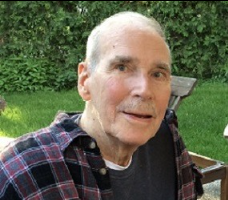OCTOBER 4, 1927 – NOVEMBER 22, 2021
Frank Sherman passed away November 22, 2021, at home attended by his wife, Barbara, daughter, Emily, and grandson, Ian Koller.
Frank Eugene Sherman was born October 4, 1927 in Lakeview Michigan. His childhood was spent in Lakeview until the Great Depression forced his parents to place him in an orphanage in Ohio. He moved to Chicago and lived on his own at age 16. Frank enlisted in the Army in January 1946, serving until discharged June 22, 1947. He attended the University of California at Berkeley on the GI bill, graduating Phi Beta Kappa. He continued at Berkeley to earn a PhD in English Literature. While in graduate school, Frank met and married Barbara Hope. They had two daughters, Celia and Emily. His teaching career began at the University of Wisconsin-Milwaukee, continued at Roosevelt College, and DePaul University, from which he retired as Professor Emeritus of American Literature in 1987.
Frank's enthusiasm for education transcended his career. He was an early supporter and proselytizer for KPFA, the pioneering Bay Area radio station. He took his family for a European tour for most of 1965. He mentored many student groups on trips to England and Europe. Frank also enjoyed travelling on his own or with Barbara, primarily to London, Paris, Vienna, and Bayreuth. During retirement, he continued his dedication to, and support of, the Chicago Symphony Orchestra and local theater. Chicago audiences and his many friends in the Arts community will be a little poorer because of his absence.
Frank is survived by his wife, Barbara; daughters, Celia Roe and Emily Sherman; grandchildren: Francesca Hugueny, Alexander Roe, and Laurel and Ian Koller; and great-granddaughter, Beatrice Hugueny.
Memorial donations in Frank’s name may be made to the Chicago Symphony Orchestra Association, Development Department, 220 S. Michigan Avenue, Chicago, IL 60604 or at: https://cso.org/support/make-a-gift/
A Celebration of Life will be held at a later date.
Source: Neptune Society: https://obituaries.neptunesociety.com/obituaries/rolling-meadows-il/frank-sherman-10458924
Photo credit: Elaine Beaudoin






